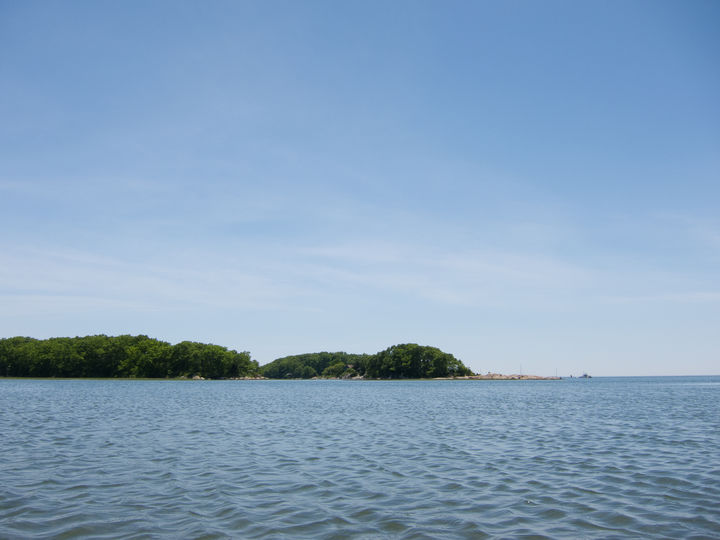Up the creek
Pattagansett River, CT, USA
“We’re sinking,”
I said.
“What?”
said M., sitting blithely unconcerned in the bow.
“I said, we’re sinking. We’re going down.”
I didn’t have time to think of any more synonyms, because the kayak, settling by the stern and filling now quite briskly, had already begun to slide beneath the surface.
We had borrowed the kayak from our kind friend C., who cast a suspicious eye on it as we carried it out of her garage.
“It might be a two-person kayak,”
she said dubiously. “And I think the hole in the bottom has been patched.”
The alternative was a much larger vessel that looked as if it would take all our joint strength to get it to the water’s edge. I was happy to take C.’s kayak, which was so light that I could lift it with one hand.
It was only when we launched it that I began to have serious doubts about whether it was in fact quite as seaworthy as I had hoped. With both of us sitting in it, the gunwales seemed perilously close to the surface of the water. An over-energetic stroke tended to send water spilling over the side, where it gleefully rushed into the stern. Matters were not helped by the fact that the most effective paddling position seemed to involve me lying right back against the stern, trying not to hit either my knees or M.’s paddle.
Gingerly, we set off upriver, bumping blades intermittently.
“Sorry,”
said M.
“No. My fault. You’re bow, which means you set the stroke. I’m supposed to follow you. It’s always my fault if our paddles hit.”
“Oh.”
Synchronizing our strokes meant faster forward progress, but I noticed that it also increased the quantity of water spilling over the side, as we tipped alternately to one side and then the other. I decided not to worry too much about style, and to concentrate on staying afloat.
Splash.
Splash.
Bump.
“Sorry.”
“No. My fault.”
“Oh.”
About half-way to the railway bridge, we hauled out on a low-lying mudbank and tipped some of the water out of the bottom. A young deer watched us doubtfully from the reeds, apparently revising its original assessment of us and concluding that if we were a threat, it was probably only to ourselves.
We reached the railway bridge at about the same time as another pair of kayaks. Their owners, a pair of rather sporty-looking women, looked trim and confident, and their clothes appeared to be entirely dry. I guessed that neither of them was probably sitting in an inch and a half of muddy water.
“Want a pump?”
called one of them cheerfully. “You’re looking a little low in the stern there.”
“We’re fine thanks,”
I called back, feeling the water sloshing around my shorts. They shrugged and turned about, heading briskly off downriver again.
We followed them at a rather slower pace, pausing for me to take photographs of a vulture that had landed among the sedge and was pecking at something dead. A yellowlegs jumped up from its nest and strutted off across the marsh, peeping shrill cries of alarm as we wallowed past. Canada geese eyed us disapprovingly.
“Which way do you want to go?”
asked M.
“Between the islands, then home,”
I said.
The channel between Huntley Island and Watts Island points almost directly towards the open sea. The water, while not exactly choppy, was more agitated than it had been further up. I became aware that the amount of water in the bottom of the kayak was definitely increasing. I took a break from paddling, and tried to bale with a narrow-mouthed glass jamjar that had previously held half our supply of drinking water. The water level continued to rise.
The end came quite abruptly. I wasn’t aware of more water entering the kayak, but suddenly the boat was half full. I clawed at the camera case that I had clipped to the front of my life jacket, as our frail vessel sank beneath me. M., having finally grasped that we were on the way to the bottom, jumped from her seat holding the plastic bag that contained our phones and a couple of apples. The kayak settled gently to the sandy bottom, while I floundered in three feet of salt water, holding my camera over my head like a post-digital Lady of the Lake.
We corraled the wayward paddles and M. set off for the shore of Watts Island, giggling furiously and holding our electronic devices over her head. I stayed behind to raise our sunken ship which, having made its point, resurfaced quite obligingly. I turned it over and pushed it, inverted, towards the shore.
On Watts Island, we emptied the kayak out and refloated it. It bobbed innocently on the surface, only a shallow puddle of the water in the bilges reminding us of its propensity to turn submarine. We decided that the wisest course was probably not to tempt fate again, so I found myself wading home, pushing the kayak ahead of me, while M. doggy-paddled alongside, still giggling.
We made landfall at the end of the back beach, amid a small army of copulating horseshoe crabs and a rather larger army of sunbathers assiduously turning themselves brick-red. The crescent-shaped strip of sand was lined with boats and families. No one seemed at all surprised to see two bedraggled figures emerge from the salt marsh, pushing a pale-green kayak in front of them. I shouldered the kayak and picked my way carefully among the slowly reddening New Englanders. I nodded to each one confidently as I passed, as if to suggest that I always celebrated Memorial Day by sinking my kayak in the middle of the channel. They looked incuriously back at me, their expressions unreadable behind their sunglasses.
